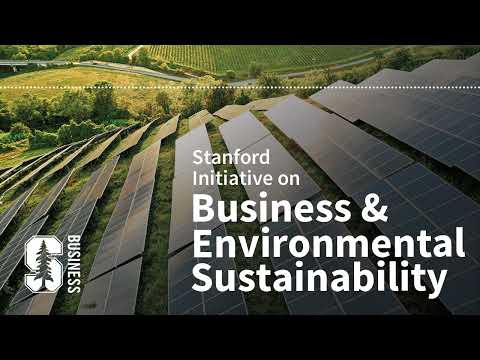New Technology-Enabled Discoveries To Understand Earth’s Seafloor for Hazards and Sustainability

[Music] greetings from Stanford University I'm Bill Barnett professor at the Stanford doors School of sustainability and the Stanford Graduate School of Business I'm Ingrid Ackerman an undergrad in the School of Engineering and we have with us here today Professor George hilly from the Department of Earth and planetary Sciences at the Stanford door School of sustainability and uh George and his colleagues just ran a conference on new technology-enabled discoveries to understand Earth's seafloor for hazards and sustainability and Ingrid you were there what did you see as some of the highlights of the conference oh this was a very intriguing conference as someone very interested in ocean science um I particularly enjoyed the new technology that was discussed using fiber optic cables on the sea floor and so if I can get us started George do you mind giving us an introduction to the sea floor what's there what are some of these hazards mentioned and some opportunities there sure well thanks first of all to um to YouTube Bill and Ingrid for having me on and inviting me to be part of your podcast um so just to go through why the sea floor itself and understanding the seafloor is important why it is important and why we want to study it and understand it more first of all um it is a place where first of all the our ability to actually image and see the seafloor is really um it's not well resolved compared to many other parts of the Earth in fact you know there's always this joke in Earth and planetary sciences that we have a better view of the surface of Mars than we do the surface of the bottom or the bottom surface of our oceans and so just from a pure exploration standpoint and Discovery based standpoint I think studying Earth sea floor is really um one of these vast areas of exploration that you know is um something that we're very interested in in addition there are practical reasons for caring about why the um or understanding what goes on in uh along Earth sea floor from the standpoint of a an earth scientist of which I am um the seafloor hosts features that often are responsible for generating the largest earthquakes on the planet and being able to actually understand those types of events including potentially even precursor emotions that might be associated with build up to large events requires us to be able to go into these very inaccessible areas to instrument them and to actually see these and understand and study these precursors if they do in fact exist we've been really hampered in our ability to understand these types of large earthquakes by the fact that we have really not been able to get close to them because of our inability to actually properly instrument the sea floor that's all changing now because there's a lot of new technologies that are in play uh to be able to measure these subtle changes in the sea floor the types of signals that are that are could be observed near these types of earthquake generating faults that allow us to really you know study those types of processes and and ways that we never have been able to before also from a very practical standpoint from the standpoint of green energy I think it's very important and the modern world of telecommunications studying our sea floor is very important because first of all that's the most important way in which we actually get data across the ocean is through seafloor fiber optic cables and being able to understand what might jeopardize those types of cables is very important for our telecommunications infrastructure those have to do with the processes and operation across earth sea floor additionally one of the important components of a green energy infrastructure is going to be um resources renewable resources such as offshore wind that's going to require a lot of infrastructure on the sea floor in order to both get data back about the offshore wind farms as well as transmit power and those are all going to be susceptible to damages caused by seafloor processes so the better we can understand those processes the better we can cite the specific infrastructure that's going to be necessary in order for us to achieve our green energy goals thank you for diving into the importance a question I have for you is regarding where we are currently so maybe two or three hundred years ago scientists and voyagers back in the day were taking weighted ropes and dropping them down to the bottom of the sea floor to create these maps of what they could discern about the bottom of the ocean but now today we're at the sort of explosion of technology and there's so many different things going on in the industry could you Enlighten us about a few of those how far have we come oh we've come a long way from the uh from the early days for sure um there's a number of key Technologies I think in terms of actually understanding and um Imaging the shape of Earth's seafloor which is very important um the first of which is you know you can think of it kind of in two categories one well even three one what we can see from satellites one what we can see from another what we can see from ships and yet another what we can see from submersible vehicles and really the modern Innovations have to do with our ability to first of all from ship-based observations be able to image or seafloor at much higher resolutions than we have been because of developments in sonar um high resolution sonar on ships but really the technology that's been that's allowed us to really get these high resolution depictions of our seafloor have been these autonomous underwater vehicles or auvs and these vehicles are really quite amazing in their construction so they're they're they're basically these little Torpedoes that you can launch off of ships they're completely self-guided and autonomous throughout their mapping Mission and they can basically Fly Above the seafloor surface the seafloor surface and um actually image with high resolution sonar in great detail the ocean bottom geometry as well as collect other types of data as well and so what that's allowed us to do I think is really to image or seafloor at for instance this the same types of resolutions that we've now been able to achieve on land by laser altimetry on the order of a meter resolution so we can get this very high resolution depiction of the seafloor which really allows us to see processes that sculpt and hazards that influence infrastructure on the ocean bottom at the scale at which they occur this is again just for background but um you know my work is on the shape of Earth's surface and how that reflects the hazards and processes um my work has been almost but not recently to until about five years ago my work has been almost entirely on land because those were the areas in which we could obtain the requisite data to actually perform those types of studies interesting okay and with these you know there's a whole other community with Hui who that have basically it's it's a Marine geophysics Marine Science community and um the types of studies that the on land hazards geomorphologists do are very different because they try to capture the signature and Landscapes of these processes in action because ship-based data cannot actually achieve those resolutions relating the individual processes and the action of those processes to features on Earth's surface before even the 1990s was very difficult since the 1990s technological innovation and the field of laser altimetry Airborne laser altimetry has really allowed us to make the link between what you actually see in the landscape in the hazard the events that occur and now with the new technologies on the seafloor we're actually starting to be able to do a similar type of um you know there's an explosion of similar types of studies where you can begin to actually see the hazards at the scale that they occur so that you can actually study them you know for for the actual events themselves and that's been enabled by this new imaging technology do you mind defining laser altimetry oh sure yeah so the uh Airborne laser altimetry that we've used on land is basically using laser pulses that are emitted at the ground and then are scattered back towards a a um or reflected back towards a receiver um and what you're basically doing is just measuring the delay between the beginning of the laser pulse in its receipt back at a plane and when you couple that with a high res or high Precision GPS navigation and inertial measurement unit uh inertial uh navigation you can actually get a very high resolution picture with very high frequency laser scanners as to what the surface of Earth actually looks like on the order of less than a meter and and you can do that Under the Sea now as well it's a slightly different technology although the there are some outfits that we saw at the conference that are using um some form of light this lidar laser laser ranging in order to actually image very high resolution um portions of the seafloor the areas in which you can do that right now are pretty restricted but the technologies that are used um in the uh you know for Imaging the seafloor are things like acoustic methods so I'm I'm curious as to here's our right now now in this undersea world of exploration um do you mind discussing how it has changed in recent years yeah so um the main people that I tend to work with um are located down uh in Monterey Bay at the Monterey Bay Aquarium Research Institute it's a really interesting place because it's a combination of science and technology so and engineering and so they are supported by the Packard Foundation mostly in order to develop new technologies for understanding um you know Earth's oceans in general which includes the seafloor and though they pair the engineers with science staff as well so that the scientists and Engineers are working in tandem to both develop the new technologies produce the data and then be able to you know have this you know kind of cycle in which the the new new technology needs are communicated to the engineers and new discoveries can be made by the scientists in this iteration fascinating um but more broadly if we if we kind of scale out here how much of this discovery and exploration is taking place in Academia and perhaps by governments versus by private sector industry corporations so there is a great need and has been a great need for these types of Imaging Technologies um especially for um seating offshore infrastructure um those include for instance fiber optic telecommunication cables when you're actually going to spend a lot of money laying a cable you need to know what the hazards are that are faced by those cables pipelines or whatever whatever it is that you need to you know put on the sea floor as well as the you know how reliable is the substrate in which you're going to embed that infrastructure and so these types of Technologies can actually give you really good information on both of those and are key to I think really are Telecommunications system as well as future opportunities in green emphasis green energy infrastructure that's located offshore you know that's interesting and as I'm hearing you talk George I I am thinking back over the various podcasts that Ingrid and I have done this year and so many of the the conferences feature to focus on climate climate change uh obviously those are massive uh uh issues in the in the in across uh all Academia and um how how do those topics come up uh for your field and for its work and and was any of that featured at the conference yes so in terms of the specific applications towards climate and sustainability applications that the the conference I think that there are many first of all one of the important aspects of our changing climate is the fact that it is going to cause people to migrate into different areas that may face greater exposure to Natural hazards in general one of the issues that we face for instance in my field in which we're trying to understand natural hazards that could be caused by for instance earthquakes is that our ability to actually characterize and understand how much of a hazard there might be really depends on our ability to see those types of structures we can do that on land because we have direct observation we can we can walk those you know walk the areas we can we have satellites that can image those features we have Airborne laser altimetry in which we can actually very well characterize and locate areas for further investigation and the offshore on the other hand these areas because of their poor Imaging really have a whole host of hidden hazards out there and even if you just look at a map of where faults might be you can see there's a very high density of faults that we know about on land and that density decreases quite rapidly As you move across the coastline one might wonder as to whether or not that exists just because we can't see them yeah and so our ability to actually image these areas with this new technology really allows us to characterize the hazard much better and that will definitely help us to understand how different populations as they have to migrate into different areas May face more more risk in that that regard oh interesting and perhaps as a final wrap-up question George what it was maybe one of your favorite takeaways or the most interesting things that you learned at the conference one of the most exciting aspects of the conference um that I found were actually two first of all the use of this high resolution bathymetry to help us seat green energy infrastructure was really exciting to me and the reason is is because um while we have many aspirations as to how how we're going to actually deploy in an abstract census this green energy infrastructure we still have to have the ability to cite it properly in a way that's going to be resilient to processes over time and so to see that application um I thought was very exciting along those lines the other aspect that I found particularly exciting is the entry of um really scale to collecting these types of measurements that is now starting to be provided by commercial outfits that basically have developed a range of Technologies very exciting Technologies to be able to really start to collect some of these data at a scale that is appropriate for exciting large amounts of offshore infrastructure for for instance green energy applications for instance some of the companies that were there we're basically developing um ships in order to deploy fleets of these autonomous underwater vehicles and these ships were basically lightly crewed with only a couple of people on them and telemetered back to offices by a starlink in which all of the operations were carried out remotely and this increases uptime of the ship's operations it reduces cost because of these lightly crewed vessels they have a fleet of basically these somewhat robotic ships out there that can basically measure seafloor with fleets of auvs 24 7 which is really going to make it possible to take what have previously been kind of small footprint observations and scale them up to much larger areas where we can actually see a range of these processes going on and a be able to characterize for instance an entire wind farm field in order to actually put in the infrastructure properly and so this kind of scaling up of the data footprint and scaling down of the cost is really going to be I think revolutionary you know for our for our audience I mean they're they're as background uh I know that that many of those who do research on uh alternative energies we'll talk about the feasibility of an energy in terms of the amount of space that it is required for it for it to to to operate and obviously for for wind uh typically we think of that space as being very large compared to the amount of power that's created well George it sounds like the kinds of Technologies you're talking about open up the vast space of the ocean for uh additional exploitation of wind energy that might not have been feasible if we couldn't uh cite those facilities absolutely all right well George hilly thank you so much for joining us today uh and Ingrid thank you well thanks Bill and thanks Ingrid again and to all of you listening until next time Stanford initiative on business and environmental sustainability podcast series is sponsored by the Stanford Graduate School of Business and the Stanford door School of sustainability music by charged particles that's Caleb hutzler Mike Rock and John prosnik [Music]
2023-05-23 16:46


